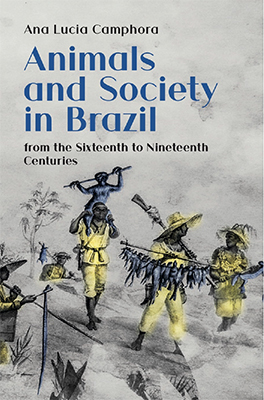Animals and Society in Brazil, from the Sixteenth to Nineteenth Centuries

Ana Lucia Camphora
This pioneering overview of how social relations were constructed as interspecies relations offers the reader a starting point for bringing these encounters into a historical narrative that unfolds over the course of several centuries of Portuguese South American colonial life. In showing the decisive importance of non-human animals in the development of Brazilian society, this volume provides a point of departure for the construction of an international corpus of knowledge in the fields of environmental history and human-animal studies, adding complexity to existing narratives and throwing new light on the role of Latin American societies within the global picture. Brazil, the largest country in South America, is home to some of the planet’s richest fauna, is ranked as one of the world’s largest meat producers (beef, chicken and pork) and also has a huge population of pets, estimated at 54.2 million dogs, 39.8 million birds and 23.9 million cats, according to a 2018 survey. Non-human animals have always been there, domesticated or wild, alongside their human counterparts. These sets of relationships configure what is still a less-understood part of Brazilian history. In its six chapters, this book considers the exotic wildlife diet base adopted by European explorers; the uses of animals for medicinal purposes; intense hunting and whaling activities; and the introduction of domesticated animals from Europe and other Portuguese colonies, focusing on the decisive contributions of cattle, horses and mules in the occupation and colonisation of the extensive Brazilian territory, and the precarious system of meat supply in the-then capital, Rio de Janeiro, in the nineteenth century.
LOOK INSIDE THIS BOOK at Amazon.co.uk
THE AUTHOR
Ana Lucia Camphora was born and lives in Rio de Janeiro, Brazil, and has degrees in Pyschology and Social Sciences. Her interdisciplinary approach is rooted in previous works as an environmental consultant in economic sustainability of protected areas, environmental policy instruments and ecotourism, in partnership with Brazilian Environmental Ministry, UNESCO and NGOs. Latterly, she has moved into interspecies studies and taught postgraduate courses in Environmental Law and Animals in Law (2015 to 2018). The Portuguese edition of Animals and Society in Brazil from the 16th to the 19th Century was published in 2017.
THE TRANSLATOR
Miriam Adelman teaches at the Federal University of Paraná, Brazil. She has published widely on Brazilian equestrian cultures and practices, from cultural studies and sociological perspectives. She works as a freelance translator of academic texts.
‘Animals and Society in Brazil introduces a broad set of themes and, hence, makes a suitable first introduction to the possibilities of the field.’
Shawn William Miller – Agricultural History
‘Camphora’s book brings us a step closer in the shared attempt to re-imagine the social as a broader and more inclusive concept. It serves the interest of academic readers as well as a broader audience thanks to the rich data and illustrations.’
Orsolya Barna – Environment and History
‘Throughout the book, Camphora points to moments of reckoning, when humans sought to reform or overturn their treatment of nonhuman animals that lived both among them and beyond the reach of human society. Along these lines, the book succeeds admirably in giving readers an opportunity to consider the need for more circumspect approaches to nonhuman and human relations in the present and the future …’
Kirsten Schultz – H-Net
‘… there is much that remains to be done in the field of Brazilian animal studies, but Camphora has fulfilled her mission by showing readers that this is an overlooked field with a multiplicity of sources to enrich the global history of nonhuman animals.’
ABEL A. ALVES – Bulletin of Spanish Studies
‘… a readable and well-researched study …’
David Wilson – Anthrozoos
CONTENTS
Introduction
1. The natural provisions of the land
2. In sickness and in health
3. Hunters and whalers
4. Animals that disembarked in Brazil
5. Horses, mules and mulattos
6. Whipping posts and slaughterhouses: The city of Rio de Janeiro in the nineteenth century
Conclusion
Publication date, 15 March 2021
ISBN 978-1-912186-17-4 (HB) 220pp. £65
